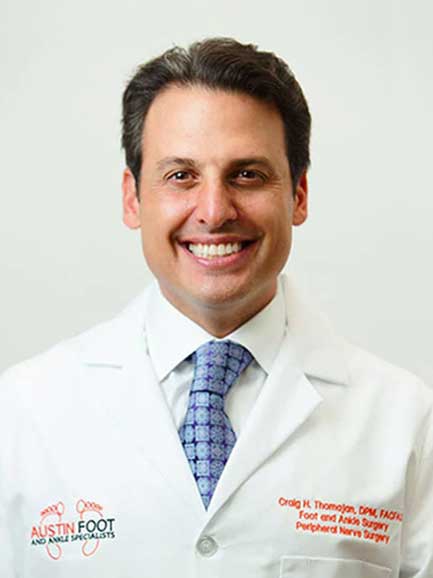
You’ve finally taken the step toward lasting relief from bunion pain. The surgery is behind you, but now comes the part that can make all the difference—your recovery. Whether you’re eager to get back to walking the trails at Lady Bird Lake or simply want to slip into shoes without discomfort, what you do in the weeks after Lapiplasty surgery will have a big impact on your results.
At Austin Foot and Ankle Specialists, Dr. Craig H. Thomajan and his team have guided many patients through this process. With the right bunion surgery aftercare, you can protect your repair, reduce discomfort, and regain function without setbacks.
Why Lapiplasty Recovery Is Different
Lapiplasty corrects bunions in three dimensions, stabilizing the root joint problem rather than just shaving off the bump. This advanced approach often allows for earlier mobility than traditional bunion surgery, but recovery is still just as important to give your bones, ligaments, and tendons time to heal in their new alignment. Rushing this process risks undoing the correction.
Key differences in recovery include:
- Earlier weight-bearing (in some cases). Many patients can walk in a protective boot within days.
- Joint stabilization focus. The bone realignment needs time to heal fully before it’s ready for full activity.
- Long-term alignment protection. Proper aftercare helps ensure the bunion doesn’t return.
First Few Days: Set the Stage for Effective Healing
It’s crucial to control swelling, minimizing pain, and protecting your surgical site in the first 72 hours after lapiplasty surgery, when your body’s inflammatory response is at its peak. Even small steps toward comfort can make a big difference in long-term healing.
Top strategies include:
- Elevating above heart level. This reduces swelling and speeds healing by improving circulation.
- Icing in short bursts. Apply 15–20 minutes at a time, with a cloth barrier to protect your skin.
- Following weight-bearing instructions. Use your walking boot and crutches exactly as directed by your surgeon.
- Staying ahead of pain. Take prescribed or recommended medication before pain becomes severe.
During this stage, your goal is rest and protection. Even though Lapiplasty may allow some mobility, resist the urge to test your limits. Overexertion early on can increase swelling and strain healing tissues.
Weeks 1–3: Build Stability and Mobility
By this point, your discomfort should start to ease, but your foot is still healing internally. This stage is about balancing gentle activity with ongoing protection while your bone tissues knit together and the muscles and ligaments of your foot adjust to their new normal.
Your priorities should be:
- Wearing your protective boot consistently. Accidental bumps can contribute to bunion recurrence, so it’s important to ensure safe weight distribution.
- Keeping the incision clean and dry. Proper wound care reduces infection risk.
- Introducing light movement. Begin practicing gentle range-of-motion exercises to maintain flexibility, as long as your doctor gives you the all-clear.
While it may be tempting to walk more or resume chores, moderation is essential. Avoid long periods of standing, and watch for swelling. If you see persistent puffiness, your foot needs more rest before you jump back into your daily habits.
Weeks 4–6: The Transition Back into Daily Life
Many patients feel ready to return to their normal footwear and routines at this stage. But make sure your transition is a gradual one to prevent stress on the healing joint.
To make the transition safely:
- Choose roomy, supportive shoes. A wide toe box prevents pressure on the surgical site.
- Increase activity in small steps. Short, frequent walks are safer than long outings.
- Begin physical therapy if recommended. Strengthening exercises help maintain proper gait and balance.
This period can be encouraging because you start to see real improvements in mobility and comfort. Just remember that bone healing continues for months—supportive shoes and sensible activity choices will protect your progress.
Long-Term Recovery: Protecting Your Results
Once you’re back to most daily activities, ongoing habits will determine how well your Lapiplasty results last. Foot health is a lifelong investment, and protecting the stability you’ve regained should be part of your daily routine.
Helpful long-term habits include:
- Maintain a healthy weight. Avoiding excess weight reduces pressure on your feet.
- Wear supportive footwear and custom orthotics. Proper footwear and custom orthotics, when necessary, help prevent recurrence and supports joint stability.
- Stay active in low-impact ways. Swimming, cycling, and walking are excellent choices.
- Monitor for changes. Contact your surgeon if you notice swelling, pain, or changes in foot shape.
Consistent care ensures your feet remain strong, stable, and pain-free for years to come.
Common Recovery Mistakes to Avoid
It’s easy to make choices that slow or derail recovery, especially if you’re anxious to get back on your feet.
Watch out for these pitfalls:
- Trying too much activity too soon and causing swelling or strain
- Skipping follow-up doctor appointments to track healing progress
- Wearing improper footwear too early
- Ignoring pain, swelling, or unusual sensations in your foot
Protect your surgical investment and ensures a smoother transition to full activity by avoiding this common mistakes
The Payoff of a Careful Recovery
Recovering from Lapiplasty requires patience, but the rewards are worth it. You can set yourself up for a future of comfortable movement and improved foot health by following a careful bunion surgery aftercare plan. This will help you enjoy Austin’s trails, parks, and city streets more in the long run, without the shadow of bunion pain to hold you back.

